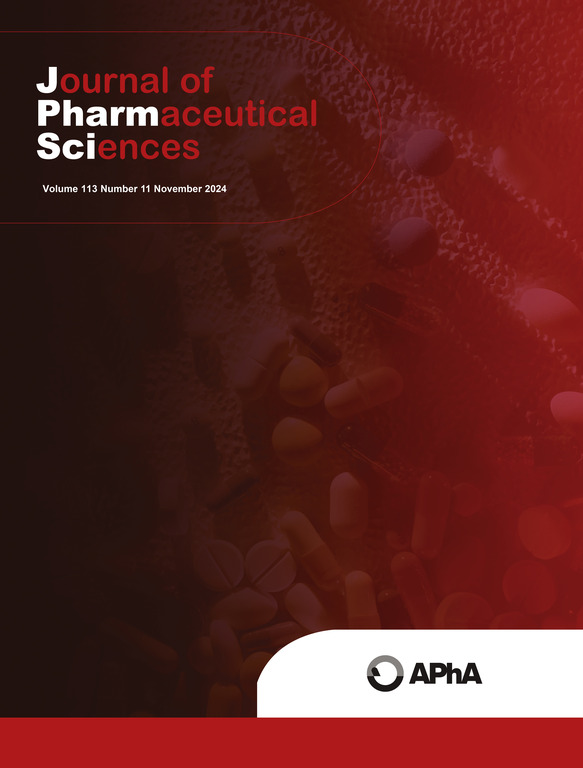Dissolving Microneedles Patch: A Promising Approach for Advancing Transdermal Delivery of Antischizophrenic Drug
IF 3.7
3区 医学
Q2 CHEMISTRY, MEDICINAL
引用次数: 0
Abstract
Objective
Microneedles (MNs) are minimally invasive transdermal drug delivery systems capable of penetrating the stratum corneum to overcome the barrier properties. The primary objective of this research was to prepare dissolving microneedle patches (DMNP) loaded with quetiapine (QTP).
Methods
DMNP were fabricated employing the solvent casting technique, utilizing various polymer feed ratios including polyvinyl alcohol (PVA), polyvinylpyrrolidone K30 (PVP-K30), and polylactide-co-glycolide (PLGA) polymers. The loaded DMNP with QTP underwent a comprehensive characterization process encompassing assessments for compatibility, thickness, insertion potential, morphology, thermal behavior, X-ray diffraction, ex-vivo permeation, skin irritation, and histopathological changes.
Results
FTIR studies confirmed the compatibility of QTP with the microneedle patch composites. The thickness of the drug-loaded DMNP ranged from 0.67 mm to 0.97 mm. These microneedles exhibited an impressive penetration depth of 480 μm, with over 80% of the needles maintaining their original shape after piercing Parafilm-M. SEM analysis of the optimized DMNP-2 revealed the formation of sharp-tipped and uniformly surfaced needles, measuring 570 μm in length. Remarkably, the microneedles did not elicit any signs of irritation upon application of the prepared DMNP. The DMNP-2 showcased an impressive cumulative ex-vivo permeation of QTP, reaching 17.82 µg/cm2/hr. Additionally, histopathological assessment of vital organs in rabbits attested to the safety profile of the formulated microneedle patches.
Conclusions
In conclusion, the developed microneedle patch represents a promising strategy for enhancing the transdermal delivery of QTP. This innovative approach has the potential to increase patient compliance, offering a more efficient and patient-friendly method of administering QTP.
溶解微针贴片:推进抗精神分裂症药物透皮给药的可行方法。
目的:微针(MNs)是一种微创透皮给药系统,能够穿透角质层,克服屏障特性。本研究的主要目的是制备含有喹硫平(QTP)的可溶解微针贴片(DMNP):方法:采用溶剂浇铸技术,利用不同的聚合物进料比(包括聚乙烯醇(PVA)、聚乙烯吡咯烷酮 K30(PVP-K30)和聚乳酸共聚乙二醇(PLGA)聚合物)制备 DMNP。装载了 QTP 的 DMNP 经过了全面的表征过程,包括相容性、厚度、插入潜力、形态、热行为、X 射线衍射、体内外渗透、皮肤刺激性和组织病理学变化等方面的评估:傅立叶变换红外光谱研究证实了 QTP 与微针贴片复合材料的相容性。载药 DMNP 的厚度在 0.67 毫米到 0.97 毫米之间。这些微针的穿透深度达到了 480 μm,穿透 Parafilm-M 后,超过 80% 的微针保持了原来的形状。对优化后的 DMNP-2 进行的扫描电镜分析表明,形成的针尖尖锐、表面均匀,长度为 570 μm。值得注意的是,在使用制备的 DMNP 时,微针不会引起任何刺激症状。DMNP-2 显示出令人印象深刻的 QTP 体内累积渗透率,达到 17.82 µg/cm2/hr。此外,对兔子重要器官的组织病理学评估也证明了配制的微针贴片的安全性:总之,所开发的微针贴片是增强 QTP 透皮给药的一种有前途的策略。这种创新方法有可能提高患者的依从性,提供一种更高效、更方便患者的 QTP 给药方法。
本文章由计算机程序翻译,如有差异,请以英文原文为准。
求助全文
约1分钟内获得全文
求助全文
来源期刊
CiteScore
7.30
自引率
13.20%
发文量
367
审稿时长
33 days
期刊介绍:
The Journal of Pharmaceutical Sciences will publish original research papers, original research notes, invited topical reviews (including Minireviews), and editorial commentary and news. The area of focus shall be concepts in basic pharmaceutical science and such topics as chemical processing of pharmaceuticals, including crystallization, lyophilization, chemical stability of drugs, pharmacokinetics, biopharmaceutics, pharmacodynamics, pro-drug developments, metabolic disposition of bioactive agents, dosage form design, protein-peptide chemistry and biotechnology specifically as these relate to pharmaceutical technology, and targeted drug delivery.

 求助内容:
求助内容: 应助结果提醒方式:
应助结果提醒方式:


